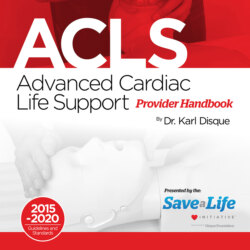Читать книгу Advanced Cardiac Life Support (ACLS) Provider Handbook - Dr. Karl Disque - Страница 5
1
INTRODUCTION TO ACLS
ОглавлениеThe goal of Advanced Cardiovascular Life Support (ACLS) is to achieve the best possible outcome for individuals who are experiencing a life-threatening event. ACLS is a series of evidence-based responses simple enough to be committed to memory and recalled under moments of stress. These ACLS protocols have been developed through research, patient case studies, clinical studies, and opinions of experts in the field. The gold standard in the United States and other countries is the course curriculum published by the Liaison Committee on Resuscitation (ILCOR).
Previously, the ILCOR released periodic updates to their Cardiopulmonary Resuscitation (CPR) and Emergency Cardiovascular Care (ECC) guidelines on a five-year cycle, with the most recent update published in 2015. Moving forward, the ILCOR will no longer wait five years between updates; instead, it will maintain the most up-to-date recommendations online at ECCguidelines.heart.org. Health care providers are recommended to supplement the materials presented in this handbook with the guidelines published by the ILCOR and refer to the most current interventions and rationales throughout their study of ACLS.
Take Note
Refer to the Basic Life Support (BLS) Provider Handbook, also presented by the Save a Life Initiative, for a more comprehensive review of the BLS Survey. This handbook specifically covers ACLS algorithms and only briefly describes BLS. All ACLS providers are presumed capable of performing BLS correctly. While this handbook covers BLS basics, it is essential that ACLS providers be proficient in BLS first.
While ACLS providers should always be mindful of timeliness, it is important to provide the intervention that most appropriately fits the needs of the individual. Proper utilization of ACLS requires rapid and accurate assessment of the individual’s condition. This not only applies to the provider’s initial assessment of an individual in distress, but also to the reassessment throughout the course of treatment with ACLS.
ACLS protocols assume that the provider may not have all of the information needed from the individual or all of the resources needed to properly use ACLS in all cases. For example, if a provider is utilizing ACLS on the side of the road, they will not have access to sophisticated devices to measure breathing or arterial blood pressure. Nevertheless, in such situations, ACLS providers have the framework to provide the best possible care in the given circumstances. ACLS algorithms are based on past performances and result in similar life-threatening cases and are intended to achieve the best possible outcome for the individual during emergencies. The foundation of all algorithms involves the systematic approach of the BLS Survey and the ACLS Survey (using steps ABCD) that you will find later in this handbook.
